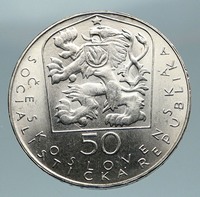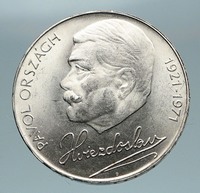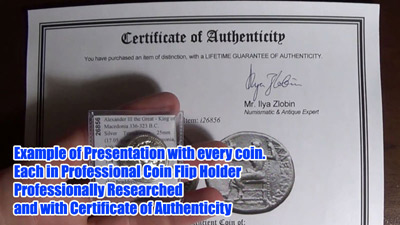Czech Republic - Czechoslovakia
50 Years - Death of Pavol Országh Hviezdoslav
1971 Silver 50 Korun 30mm (13.12 grams) 0.700 Silver (0.2926 oz. ASW)
Reference: KM# 72
ČESKOSLOVENSKÁ SOCIALISTICKÁ REPUBLIKA 50, State emblem, lion within shield.
PAVOL ORSZÁGH HVIEZDOSLAV 1921 - 1971, Hviezdoslav facing left.
You are bidding on the exact item pictured, provided with a Certificate of Authenticity and Lifetime Guarantee of Authenticity.
 Pavol Országh Hviezdoslav (2 February 1849 - 8 November 1921) was a Slovak poet, dramatist, translator, and for a short time, member of the Czechoslovak parliament. Originally, he wrote in a traditional style, but later became influenced by parnassism and modernism. Pavol Országh Hviezdoslav (2 February 1849 - 8 November 1921) was a Slovak poet, dramatist, translator, and for a short time, member of the Czechoslovak parliament. Originally, he wrote in a traditional style, but later became influenced by parnassism and modernism.
He was born as Pavel Országh. His family name is Hungarian (from ország, meaning "country"). Hviezdoslav (a Slavic name, meaning approximately "celebrating the stars" and/or "Slav of the stars") was his pseudonym from 1875. His earlier pseudonym was Jozef Zbranský. Pavel Országh was born in Vyšný Kubín (Felsőkubin), Árva County, Kingdom of Hungary, Austrian Empire. He was of noble origin. Hviezdoslav studied at grammar schools in Miskolc and Kežmarok (Késmárk) in the Hungarian lutheran school. The young Országh became a Hungarian patriot. During this time he got acquainted with the poetry of Arany János and Petőfi Sándor and under their influence he started to write poems first in Hungarian, then from the mid-1870s in Slovakian. After his graduation in 1870, he continued his studies at the Law Academy of Prešov (Eperjes), where in 1871 he participated in the preparation of the Almanach Napred ("Forward" Miscellany/Almanac), which marked the beginning of a new literary generation in Slovak literature. Due to his contribution to this Almanac with several radical poems, however, he was ignored in the literary life of the country for the rest of the 1870s and couldn't get his works published. During this period, he pursued his law career in Dolný Kubín, but he also carried on with his literary work in his free time. He practiced as a lawyer between 1875 and 1899 in Námestovo (Námesztó), and then in Dolný Kubín again. In 1918, he became a member of the newly created Revolutionary National Assembly (provisional governing body, later parliament) in Prague, and from 1919 to 1920, served as its representative. In 1919, he was chosen as the leader of the re-established Matica slovenská (Slovak matica), a Slovak cultural institute founded in 1863, and closed as a result of Hungarian policy in 1875 In 1954, the Literary Museum of P. O. Hviezdoslav was established in Dolný Kubín. A festival of amateur poetry reciters named Hviezdoslav's Kubín has been held there since. Minor planet 3980 is named Hviezdoslav. Works Hviezdoslav introduced the syllabic-tonic verse into Slovak poetry and became the leading representative of Slovak literary realism. His style is characterized by extensive use of self-coined words and expressions, making it difficult to translate his works into foreign languages. Hviezdoslav introduced the syllabic-tonic verse into Slovak poetry and became the leading representative of Slovak literary realism. His style is characterized by extensive use of self-coined words and expressions, making it difficult to translate his works into foreign languages.
His oeuvre constitutes some 12 volumes of original poetry and an additional 3 volumes of translations of classical authors. During his era, he was the poet laureate of the Slovak nation. To honor his 1905 translation, of The Tragedy of Man by Imre Madách, he was elected a member of the Kisfaludy Society in 1912. Collected works and selections- The Collected Poetical Works of Hviezdoslav, vol. 1 to 15 (Zobrané spisy básnické Hviezdoslava, zv. 1-15, 1892 - 1931)
- Biblical Poems (Básne biblické, Prague 1911)
- The Writings of P.O. Hviezdoslav in 12 volumes (Spisy P.O. Hviezdoslava v 12 zväzkoch, 1951-1957)
- Poetic First Fruits (Basnicke prvotiny I-II, 1955-1956)
- Poetic Maturing I-II (Básnicke zrenie I-II, 1957-1958)
- Works I-IV (Dielo I-IV, 1973, second edition 1997-1998)
Reflexive poetryHe began writing poetry - initially in Hungarian - while still attending grammar school (in Miskolc and Kežmarok / Késmárk)). His first poetry collection, the Básnické prviesienky Jozefa Zbranského ("Poetry primroses of Jozef Zbranský"), was published in 1868. It introduced the syllabic-tonic verse into Slovak literature. An awakened national pride brought him to resolve to work in Slovak, but the inclination towards realism in his early poetry was met with aversion by the older generation. Among the most important of his mature lyric cycles are: - Sonety (1882-1886) (Sonnets)
- Letorosty I-III (1885-1893) (Growth Rings I - III)
- Žalmy a hymny (1885-1892) (Psalms and Hymns)
- Prechádzky jarom (1898) (Walks through Spring)
- Prechádzky letom (1898) (Walks through Summer)
- Stesky (1903) (Languors/Complaints)
- Krvavé sonety (1914/1919) (Bloody Sonnets) - important anti-World War I poetry
Epic compositionsThe poet's epic compositions derive from his native Orava and from biblical topics, through which he commented allegorically on the situation of the Slovak nation: - Hájnikova žena (1884-1886) (The Gamekeeper's Wife)
- Ežo Vlkolinský (1890)
- Gábor Vlkolinský (1897-1899)
Biblical poetry- Agar
- Kain
- Ráchel
- Sen Šalamúnov (The Dream of Solomon)
Drama- Pomsta (Revenge)
- Herodes a Herodias (1909) (Herod and Herodias)- verse drama inspired by the Bible; a pillar of Slovak classic dramatic repertory.
 The Czech Republic also known by its short-form name, Czechia, is a landlocked country in Central Europe bordered by Germany to the west, Austria to the south, Slovakia to the east and Poland to the northeast. The Czech Republic covers an area of 78,866 square kilometres (30,450 sq mi) with a mostly temperate continental climate and oceanic climate. It is a unitary parliamentary republic, with 10.6 million inhabitants; its capital and largest city is Prague, with 1.3 million residents. Other major cities are Brno, Ostrava, Olomouc and Pilsen. The Czech Republic is a member of the European Union (EU), NATO, the OECD, the United Nations, the OSCE, and the Council of Europe. The Czech Republic also known by its short-form name, Czechia, is a landlocked country in Central Europe bordered by Germany to the west, Austria to the south, Slovakia to the east and Poland to the northeast. The Czech Republic covers an area of 78,866 square kilometres (30,450 sq mi) with a mostly temperate continental climate and oceanic climate. It is a unitary parliamentary republic, with 10.6 million inhabitants; its capital and largest city is Prague, with 1.3 million residents. Other major cities are Brno, Ostrava, Olomouc and Pilsen. The Czech Republic is a member of the European Union (EU), NATO, the OECD, the United Nations, the OSCE, and the Council of Europe.
It is a developed country with an advanced, high income export-oriented social market economy based in services, manufacturing and innovation. The UNDP ranks the country 14th in inequality-adjusted human development. The Czech Republic is a welfare state with a "continental" European social model, a universal health care system, tuition-free university education and is ranked 14th in the Human Capital Index. It ranks as the 6th safest or most peaceful country and is one of the most non-religious countries in the world, while achieving strong performance in democratic governance. 
 Following the Battle of Mohács in 1526, the whole Crown of Bohemia was gradually integrated into the Habsburg Monarchy alongside the Archduchy of Austria and the Kingdom of Hungary. The Protestant Bohemian Revolt (1618-20) against the Catholic Habsburgs led to the Thirty Years' War. After the Battle of the White Mountain, the Habsburgs consolidated their rule, eradicated Protestantism and reimposed Catholicism, and also adopted a policy of gradual Germanization. This contributed to the anti-Habsburg sentiment. A long history of resentment of the Catholic Church followed and still continues. With the dissolution of the Holy Roman Empire in 1806, the Bohemian Kingdom became part of the German Confederation 1815-1866 as part of Austrian Empire (1804 to 1867) and the Czech language experienced a revival as a consequence of widespread romantic nationalism. In the 19th century, the Czech lands became the industrial powerhouse of the monarchy and were subsequently the core of the Republic of Czechoslovakia, which was formed in 1918 following the collapse of the Austro-Hungarian Empire after World War I. Following the Battle of Mohács in 1526, the whole Crown of Bohemia was gradually integrated into the Habsburg Monarchy alongside the Archduchy of Austria and the Kingdom of Hungary. The Protestant Bohemian Revolt (1618-20) against the Catholic Habsburgs led to the Thirty Years' War. After the Battle of the White Mountain, the Habsburgs consolidated their rule, eradicated Protestantism and reimposed Catholicism, and also adopted a policy of gradual Germanization. This contributed to the anti-Habsburg sentiment. A long history of resentment of the Catholic Church followed and still continues. With the dissolution of the Holy Roman Empire in 1806, the Bohemian Kingdom became part of the German Confederation 1815-1866 as part of Austrian Empire (1804 to 1867) and the Czech language experienced a revival as a consequence of widespread romantic nationalism. In the 19th century, the Czech lands became the industrial powerhouse of the monarchy and were subsequently the core of the Republic of Czechoslovakia, which was formed in 1918 following the collapse of the Austro-Hungarian Empire after World War I.
Czechoslovakia remained the only democracy in this part of Europe in the interwar period. However, the Czech part of Czechoslovakia was occupied by Germany in World War II, while the Slovak region became the Slovak Republic; Czechoslovakia was liberated in 1945 by the armies of the Soviet Union and the United States. Most of the three millions of the German-speaking minority were expelled following the war. The Communist Party of Czechoslovakia won the 1946 elections and after the 1948 coup d'état, Czechoslovakia became a one-party communist state under Soviet influence. In 1968, increasing dissatisfaction with the regime culminated in a reform movement known as the Prague Spring, which ended in a Soviet-led invasion. Czechoslovakia remained occupied until the 1989 Velvet Revolution, when the communist regime collapsed and market economy was reintroduced. On 1 January 1993, Czechoslovakia peacefully dissolved, with its constituent states becoming the independent states of the Czech Republic and Slovakia. The Czech Republic joined NATO in 1999 and the EU in 2004.
|


 Pavol Országh Hviezdoslav (2 February 1849 - 8 November 1921) was a Slovak poet, dramatist, translator, and for a short time, member of the Czechoslovak parliament. Originally, he wrote in a traditional style, but later became influenced by parnassism and modernism.
Pavol Országh Hviezdoslav (2 February 1849 - 8 November 1921) was a Slovak poet, dramatist, translator, and for a short time, member of the Czechoslovak parliament. Originally, he wrote in a traditional style, but later became influenced by parnassism and modernism.  Hviezdoslav introduced the syllabic-tonic verse into Slovak poetry and became the leading representative of Slovak literary realism. His style is characterized by extensive use of self-coined words and expressions, making it difficult to translate his works into foreign languages.
Hviezdoslav introduced the syllabic-tonic verse into Slovak poetry and became the leading representative of Slovak literary realism. His style is characterized by extensive use of self-coined words and expressions, making it difficult to translate his works into foreign languages.  The Czech Republic also known by its short-form name, Czechia, is a landlocked country in Central Europe bordered by Germany to the west, Austria to the south, Slovakia to the east and Poland to the northeast. The Czech Republic covers an area of 78,866 square kilometres (30,450 sq mi) with a mostly temperate continental climate and oceanic climate. It is a unitary parliamentary republic, with 10.6 million inhabitants; its capital and largest city is Prague, with 1.3 million residents. Other major cities are Brno, Ostrava, Olomouc and Pilsen. The Czech Republic is a member of the European Union (EU), NATO, the OECD, the United Nations, the OSCE, and the Council of Europe.
The Czech Republic also known by its short-form name, Czechia, is a landlocked country in Central Europe bordered by Germany to the west, Austria to the south, Slovakia to the east and Poland to the northeast. The Czech Republic covers an area of 78,866 square kilometres (30,450 sq mi) with a mostly temperate continental climate and oceanic climate. It is a unitary parliamentary republic, with 10.6 million inhabitants; its capital and largest city is Prague, with 1.3 million residents. Other major cities are Brno, Ostrava, Olomouc and Pilsen. The Czech Republic is a member of the European Union (EU), NATO, the OECD, the United Nations, the OSCE, and the Council of Europe. 
 Following the Battle of Mohács in 1526, the whole Crown of Bohemia was gradually integrated into the Habsburg Monarchy alongside the Archduchy of Austria and the Kingdom of Hungary. The Protestant Bohemian Revolt (1618-20) against the Catholic Habsburgs led to the Thirty Years' War. After the Battle of the White Mountain, the Habsburgs consolidated their rule, eradicated Protestantism and reimposed Catholicism, and also adopted a policy of gradual Germanization. This contributed to the anti-Habsburg sentiment. A long history of resentment of the Catholic Church followed and still continues. With the dissolution of the Holy Roman Empire in 1806, the Bohemian Kingdom became part of the German Confederation 1815-1866 as part of Austrian Empire (1804 to 1867) and the Czech language experienced a revival as a consequence of widespread romantic nationalism. In the 19th century, the Czech lands became the industrial powerhouse of the monarchy and were subsequently the core of the Republic of Czechoslovakia, which was formed in 1918 following the collapse of the Austro-Hungarian Empire after World War I.
Following the Battle of Mohács in 1526, the whole Crown of Bohemia was gradually integrated into the Habsburg Monarchy alongside the Archduchy of Austria and the Kingdom of Hungary. The Protestant Bohemian Revolt (1618-20) against the Catholic Habsburgs led to the Thirty Years' War. After the Battle of the White Mountain, the Habsburgs consolidated their rule, eradicated Protestantism and reimposed Catholicism, and also adopted a policy of gradual Germanization. This contributed to the anti-Habsburg sentiment. A long history of resentment of the Catholic Church followed and still continues. With the dissolution of the Holy Roman Empire in 1806, the Bohemian Kingdom became part of the German Confederation 1815-1866 as part of Austrian Empire (1804 to 1867) and the Czech language experienced a revival as a consequence of widespread romantic nationalism. In the 19th century, the Czech lands became the industrial powerhouse of the monarchy and were subsequently the core of the Republic of Czechoslovakia, which was formed in 1918 following the collapse of the Austro-Hungarian Empire after World War I. 
